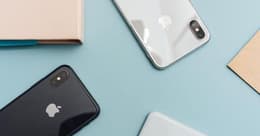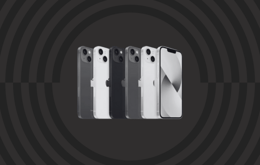
Two names consistently stand out in the growing world of smartphones: Apple’s iPhone and Samsung’s Galaxy. Choosing between these two giants can be a big commitment, given their distinct ecosystems and features. Read ahead for an in-depth iPhone vs. Galaxy comparison that details design, user experience, camera capabilities, performance, ecosystem integration, and device pricing.
Operating system
iOS for iPhone
Apple’s iOS offers a consistent and user-friendly interface across all iPhone models. This makes the experience familiar if you’ve had an Apple device in the past.
iOS has features focused on device security, like Face ID to keep bad actors out, easy system updates, and data encryption. Additionally, iOS offers features like AirDrop for quick file sharing between other Apple devices, Siri voice-activated digital assistant, and seamless integration with other Apple services such as iCloud and Apple Music.
Android for Galaxy
Samsung Galaxy devices run on Android OS, an operating system with flexibility and personalization options. Nearly all phone models except for iPhones run on Android. If you’ve had other Android-run phones, like Google Pixel or Motorola, Samsung Galaxy will feel familiar.
Android allows users to customize their home screens and use third-party widgets. Samsung adds its own flair with the One UI, which offers features such as Edge Panels for quick access to apps and contacts. It also offers Samsung DeX to use your Galaxy more like a desktop computer than a smartphone.
Apps
App Store
The App Store offers additional important security features, like app sandboxing, which restricts third-party apps from making changes to your iPhone or from accessing files stored by other apps. App Store also has strict criteria for third parties to upload apps, ensuring all apps are high-quality and secure.
Google Play
Samsung Galaxy phones and all Android phones use the Google Play store. The Google Play app approval process is less hands-on than Apple’s; however, all apps are checked for malware or viruses and for overall quality. Most major apps found on the App Store can be found on Google Play.
Ecosystem and compatibility
The Apple ecosystem
Apple devices, like iPhone, iPad, MacBook, Apple Watch, and Apple TV, work together seamlessly in Apple’s ecosystem. Features like handoff let you start a task or finish listening to a podcast on one device and finish it on another. Continuity allows for calls and messages to be taken on any device, too. iCloud, Apple’s cloud storage system, allows your data to be accessible across all devices.
The Samsung galaxy ecosystem
Galaxy smartphones integrate well with Samsung tablets, smartwatches, TVs, and smart home devices. Features like Quick Share and Samsung Cloud provide data transfer, device syncing, and backup solutions on multiple devices. Samsung’s SmartThings app allows users to control their smart home devices from their Galaxy phone. Additionally, Samsung’s partnership with Microsoft brings enhanced productivity features, including seamless syncing with Windows PCs.
Design and build quality
iPhone
Apple’s iPhones use either aluminum, titanium, or stainless steel on the outer body, depending on the model. The iPhone 15 Pro and Pro Max use titanium to lighten the device’s weight, while the iPhone 14 uses aluminum and the iPhone 14 Pro and Pro Max use stainless steel. Apple uses Ceramic Shield glass in all models beginning with iPhone 12. Many of these models have a glass back as well.
iPhone Models starting with iPhone 13 are IP68 rated, which means they’re dust-tight and water-resistant. This means your phone can be submersed in a depth up to 6 meters for up to 30 minutes without damage. Older models are also dust-tight and water-resistant, but are water-resistant to a lesser degree.
Nearly all iPhone models no longer have the home button, a once-standard design feature that was removed in 2017. The most recent model with the home button is the iPhone SE (2022).
Galaxy
Samsung Galaxy phones focus on practical design elements, such as ergonomic curves, to make their large-screen phones comfortable and easy to hold.
Many Galaxy phones use Gorilla Glass or Gorilla Glass Victus, which can be up to four times stronger than other phones that use aluminosilicate glass composite. This glass was introduced on the Galaxy Note 20 Ultra. If you tend to drop your phone, Galaxy’s strong glass may be a good reason to make the switch.
Newer Galaxy models' bodies are made of titanium (S24 Ultra) or armor aluminum (S24 and S24+). Select older models, such as the S21, use durable plastic instead of Gorilla Glass for the back. Galaxy Ultra phones, beginning with the S21 Ultra 5G, come with a built-in S Pen stylus as well.
Performance and hardware
iPhone performance
iPhones are powered by Apple’s custom-designed chipsets, which are known for their performance and efficiency. A10-A17 chips — which chip is used in which phone varies – provide excellent CPU and GPU performance, ensuring smooth multitasking, gaming, video-watching, and more.
Battery life is optimized through a combination of hardware and software. You can check on battery health and usage, which are accompanied by activity insights and optimization suggestions based on how you use your phone. iPhones support Qi wireless charging starting with the iPhone 8.
Storage options vary greatly depending on the model. Older phones can have as little as 16GB of storage, while newer models can have as much as 1TB.
iPhones also feature eSIM or Nano SIM for easier wireless network connection. Depending on the model, some phones include just an eSIM or Nano SIM card option.
Galaxy performance
Samsung Galaxy phones are equipped with powerful chipsets such as the Snapdragon 888 or Exynos 2100, depending on the region. These processors deliver strong performance for all types of tasks, from gaming to productivity.
Galaxy devices often feature larger batteries, providing longer usage times. Galaxy phones support fast charging, starting with the S6 edge+, and Qi wireless charging, starting with the Galaxy S8 and S8+.
Storage options vary depending on the model. Galaxy models have storage options ranging from 16GB to 1TB. Many Galaxy phones also offer expandable memory via microSD cards. Select Galaxy phones also offer RAM Plus, which allows for memory expansion by using the phone’s storage as virtual memory, improving multitasking and performance.
Samsung Galaxy phones offer dual SIM, eSIM, and Standard, Micro, or Nano SIM cards, depending on the chosen model.
Camera capabilities and specifications
iPhone cameras
Some iPhone models feature dual or triple camera setups, with advanced sensors and lenses that provide excellent photo and video quality. The more recent models feature a 12MP front-facing camera and a 48MP rear-facing camera, with additional MP ranges for zoom and ultra-wide settings. For the average iPhone user, these features translate into consistently high-quality photos and videos without extensive manual adjustments or professional-level photography knowledge.
Features like Night mode, Deep Fusion, and Smart HDR ensure great performance in every lighting condition, from the beaming morning sun to midnight darkness. Portrait mode offers depth-of-field effects, so one object is in focus while the background is blurred. Video capabilities support 4K recording, cinematic stabilization, and ProRAW format for professional-grade editing. You can also use QuickTake video to take photos while recording video.
Galaxy cameras
Samsung Galaxy rear cameras are available up to 200MP, a significantly higher resolution than the iPhone camera. The front-facing camera is anywhere from 4MP to 12MP, depending on the model you choose.
Galaxy frame rate settings can be adjusted for smoother motion. These devices offer auto settings for photo capturing and video recording, as well as special settings like long-exposure photos, Night, Food, Panorama, and Portrait mode for ideal picture-taking in all sorts of settings. For advanced users, Pro mode gives them control over features such as ISO for light sensitivity, shutter speed, white balance, and manual focus to make the phone feel like a DSLR camera.
Price
Brand-new iPhones start at $429 and go up to $1,599. The price depends on the storage selected, the iPhone series, and if you select Pro, Pro Max, Max, or Standard models. To get a great phone on a budget, refurbished iPhones offer the same quality with more models to choose from. Back Market’s refurbished iPhones typically range from less than $100 to $1,000, depending on the model, storage size, the phone’s physical condition, and other factors.
Brand-new Samsung Galaxy phones start at $399.99 and go up to $2,159.99, depending on the model and storage size. Just like the iPhone, Back Market offers refurbished Samsung Galaxy phones that bring the same features and performance quality as a new device, for a wallet-friendly price. Back Market’s Samsung Galaxy price range is between less than $100 to less than $2,000.
iPhone vs Galaxy comparison chart
Feature | iPhone | Galaxy |
Operating system (OS) | iOS | Android OS with Samsung One UI |
Chipsets (SoC) | A10-A17, depending on model | Exynos or Snapdragon, depending on model |
Central Processing Unit (CPU) | 6-core | Octa-core or Quad-Core, depending on model |
RAM | 2GB-8GB, depending on model | 2GB-16GB, depending on model |
Storage | 16GB-1TB, depending on model | 16GB-1TB, depending on model |
Compatibility | Other Apple devices, wallets, wireless chargers, and more, depending on model | S Pen, Smart Watch, Microsoft computers, depending on model |
Camera megapixel: Front | 7MP-12MP, depending on the setting and model | 4MP-12MP |
Camera megapixel: Rear | Up to 48MP | Up to 200MP |
Build materials | Stainless steel, aluminum, or titanium frame, depending on model Ceramic Shield glass, beginning with iPhone 12 | Corning Gorilla Glass or Gorilla Glass Victus, depending on model Aluminum or Titanium frame, depending on model |
SIM card | eSIM and/or Nano SIM, depending on model | Dual SIM, eSIM, and Standard, Micro, or Nano SIM, depending on model |
Weight | 144 - 240 grams, depending on model | 102 - 263 grams, depending on model |
Full screen size | 4.7 - 6.7 inches, depending on model | 4.7 - 7.6 inches, depending on model |
Phone measurements | Height*: 5.45” - 6.33” Width: 2.65” - 3.02” Depth: 0.29” - 0.33” Depending on model | Height^: 3.34” - 6.8” Width: 2.64” - 3.11” Deth: 0.27” - 0.34” Depending on model |
*The smallest iPhone measured is the iPhone SE. The largest iPhone measured is the iPhone 15 Pro Max.
^The smallest Galaxy phone measured is the Samsung Galaxy S10E. The largest Galaxy phone measured is the Galaxy S24 Ultra. Measurements do not include the Galaxy Z Flip5 or the Galaxy Fold.
iPhone vs. Galaxy: Which is right for you?
Choosing between an iPhone and a Galaxy phone ultimately comes down to personal preference and needs. If you value a seamless ecosystem, regular updates, and a polished user experience, an iPhone may be the better choice. On the other hand, if you prefer customization, a broader range of hardware options, and cutting-edge camera technology, a Samsung Galaxy may be more suitable.
Consider what aspects are most important to you, such as design, camera capabilities, and ecosystem integration, to make the best decision for your newly refurbished phone pick.
Discover refurbished iPhone and Galaxy models on Back Market
Make your next phone a refurbished one with Back Market. Better for your wallet and the planet, a refurbished phone offers all the features you need for work and play without the price tag of a brand-new device. Transparent device grading and ratings, free 30-day returns, and a 1-year warranty mean that you can shop for your new-to-you iPhone or Galaxy worry-free. No matter which device you choose, shop now to find the best models and prices for your lifestyle.













